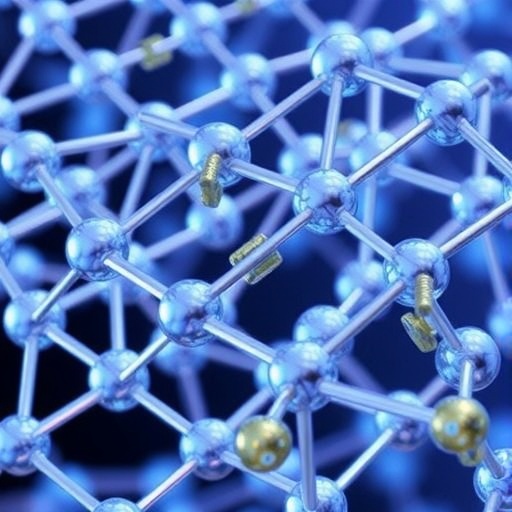In the relentless pursuit of faster, safer, and longer-lasting lithium-ion batteries, a persistent obstacle has been the sluggish desolvation and transport of lithium ions at the graphite anode during extreme fast charging. This fundamental challenge has impeded the scale-up of rapid charging technologies essential for applications ranging from portable electronics to electric vehicles. A groundbreaking breakthrough from researchers at Central South University and Nanjing University now promises to revolutionize the field with the development of a glassy metal-organic framework (MOF) coating that redefines the ion transport paradigm within the graphite anode.
The traditional bottleneck arises because lithium ions, solvated in the electrolyte, must first shed their solvent shells—a process called desolvation—before they can intercalate into graphite layers. Under rapid charging conditions, this desolvation step becomes rate-limiting, causing lithium ions to deposit as metallic lithium on the anode surface, which leads to hazardous dendrite growth and rapid capacity degradation. Conventional approaches such as the use of highly concentrated electrolytes or surface coatings have provided incremental improvements but often at the cost of reduced rate capabilities, increased manufacturing complexity, or higher production costs.
Addressing this multifaceted challenge, the research team led by Professors Zhi Chang and Haoshen Zhou designed and fabricated an ultrathin (~5 nm) glassy MOF coating that transforms the graphite anode’s surface chemistry and interface dynamics. This novel coating performs two critical functions through its dynamic structural evolution during the initial electrochemical cycle. In its initial state, it acts as a uniform gatekeeper layer. With cycling, it evolves into a dual-layer architecture comprising an outer sub-nanometer pore MOF glass layer and an inner lithium phosphide (Li₃P) enriched layer on the graphite surface.
The outer MOF glass layer is engineered with highly selective pores measuring approximately 2.93 angstroms in diameter. These nanoscale channels function as an effective molecular sieve, enforcing lithium-ion pre-desolvation by stripping off solvent molecules from lithium ions before their entry into the electrode. This pre-desolvation mechanism not only accelerates ion kinetics but also fosters a highly concentrated ionic environment at the interface, crucial for the formation of a robust, LiF-rich solid electrolyte interphase (SEI). This unique SEI chemistry is pivotal in suppressing dendritic lithium growth and enhancing long-term battery safety and stability.
Simultaneously, the inner layer enriched with Li₃P serves as an ultrafast ionic conductor. Li₃P boasts excellent lithium-ion conductivity, effectively acting as an ion accelerator that facilitates the rapid diffusion of partially desolvated lithium ions into the graphite bulk. By decoupling the slow desolvation stage from subsequent solid-state ion transport within the anode, this dual-layer configuration significantly enhances the overall ion transport rates, enabling extremely fast charging without compromising electrode integrity.
Experimentally, the coated Glass@Graphite anode exhibits extraordinary electrochemical performance. In half-cell configurations, it delivers a specific capacity exceeding 250 mAh/g at ultrahigh rates of 5C—over five times the capacity retention compared to uncoated graphite electrodes under identical conditions. These impressive capabilities translate effectively to practical full-cell architectures, where the Glass@Graphite anode is paired with commercial nickel-rich NCM-811 cathodes. The resulting batteries demonstrate remarkable operational durability, retaining 88% of their initial capacity even after 1,000 cycles at a stringent 4C charging rate.
To showcase industrial viability, the researchers scaled up the technology to a 2.36 Ah pouch cell format. This larger cell maintained a competitive energy density of 283 Wh/kg and preserved more than 80% capacity after 300 fast-charge cycles. Post-mortem characterization of the electrodes confirmed a pristine graphite surface void of lithium dendrites and a stable crystal lattice structure, underscoring the coating’s protective function over extended cycling.
What sets this innovation apart is the marriage of nanoscale precision engineering with scalable, low-temperature synthesis techniques. Unlike many nano-coating approaches requiring high-temperature or complex processing steps incompatible with current battery manufacturing lines, the MOF glass coating can be applied using cost-effective, industry-friendly methods, paving the way for seamless adoption in existing production infrastructures.
Fundamentally, this work redefines the role of interfacial layers in high-performance lithium-ion batteries. Rather than simply blocking or passivating the electrode surface, the glassy MOF coating acts as an active interface that orchestrates ion dynamics—accelerating desolvation and enhancing lithium-ion mobility while concurrently promoting the growth of a stable, protective SEI. This sophisticated multifunctionality resolves the enduring trade-off between rapid charging capability and long-term cycle life.
Looking ahead, the implications of this technology extend beyond graphite anodes. The principles of selective ion sieving coupled with fast ionic conduction could inform the design of next-generation interfaces for other electrode materials where ion transport limitations govern performance. Moreover, the ability to precisely control interfacial chemistry through dynamic, self-adaptive coatings potentially opens new horizons in battery material science, helping usher in a new era of energy storage devices that combine speed, safety, and longevity.
In essence, the glassy MOF nano-sieve coating represents a quantum leap in lithium-ion battery technology. It addresses the central challenge of desolvation kinetics without sacrificing the essential attributes of electrode stability and manufacturability. As global demand for rapid, reliable battery charging continues to intensify, this breakthrough offers a promising avenue to accelerate the electrification of transportation, grid storage solutions, and myriad portable electronics, fundamentally transforming the battery landscape for decades to come.
Subject of Research:
Article Title:
News Publication Date:
Web References: http://dx.doi.org/10.1093/nsr/nwaf349
References:
Image Credits: ©Science China Press
Keywords
Lithium-ion battery, fast charging, graphite anode, metal-organic framework, MOF glass coating, lithium-ion desolvation, solid electrolyte interphase, SEI, lithium phosphide, Li₃P, electrochemical performance, molecular sieve, battery interface engineering




